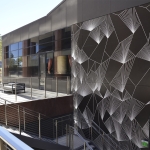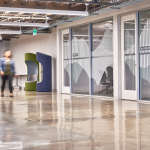Wayfinding is a system of guiding people through physical spaces such as buildings, campuses, neighborhoods, and even entire cities. Wayfinding is the process of providing an intuitive experience that ensures people can easily find their way or locate a particular destination without confusion or frustration. Wayfinding solutions typically include directional markers such as maps, signage, kiosks, and audio/visual cues which are designed to lead people securely and efficiently from one point to another.
Wayfinding systems are often used to ensure the smooth movement of pedestrians in high-traffic areas such as airports, shopping malls, university campuses, and public transportation hubs.
How to use wayfinding signage?
At its most basic level, wayfinding provides guidance on how to navigate from point A to point B—but it can also provide valuable information about the environment including the availability of services such as restrooms or points of interest like art installations.
Wayfinding can also be utilized for branding purposes when elements like logos and colors are connected with a company’s identity and are used in signs and other visual cues. This helps create immersive experiences for visitors that have an emotional connection with a brand.
Effective wayfinding must also consider environmental factors that may impact navigation such as lighting levels, obstacles, noise levels, or crowdedness.
In order to create an intuitive path-following experience, designers must take into account variables like these in order to produce an effective design solution.
Additionally, designers should make sure that they are familiar with the space they are working on—especially if it’s a large facility where foot traffic patterns change over time—so they can adjust designs accordingly. Wayfinding solutions should be dynamic enough to accommodate changes in foot traffic due to events or new construction projects while still being able to provide visitors with clear directions at all times.
The Importance of Wayfinding in Interior Design
Wayfinding is an important aspect of interior design. It provides a sense of direction by guiding users through the space while also enhancing the overall design aesthetic. Wayfinding should be designed to be intuitive and easy to follow, as well as visually appealing so that it creates a positive experience for visitors.
Wayfinding systems can be used to highlight key features or points of interest within a space by using consistent visual cues such as colors, symbols or icons that are easily recognizable and understood by visitors.
Wayfinding can also help create cohesive branding elements throughout a physical space, which strengthens the visitor’s connection with the brand. This helps ensure that visitors have a positive experience when navigating the space and helps establish an emotional connection with the business.
What does a successful wayfinding system look like?
A successful wayfinding system should integrate seamlessly into the existing design and architecture of the environment in order to provide clear directions without being intrusive or overwhelming. A good wayfinding system will also take into account environmental factors such as lighting levels, obstacles, noise levels or crowdedness in order to ensure that navigation is safe and efficient. Additionally, designers should have an understanding of how foot traffic patterns change over time so they can adjust signage accordingly in order to maintain accurate directional guidance at all times.
By combining effective wayfinding strategies with interior design elements like color palettes, textures, materials and furniture selection, businesses can create engaging spaces that are welcoming and inviting while still working towards achieving their overall objectives such as increased customer engagement or improved sales conversions.
Conclusion
Wayfinding is essential for any business due to its ability to enhance customer experiences while also working towards functional goals such as efficient navigation and optimized flow of traffic within a space.From providing basic directional guidance to creating branded experiences, wayfinding plays an essential role in effective interior design.




